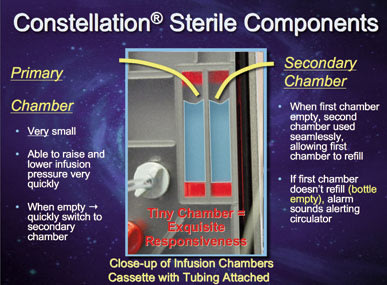ADVANCEMENTS IN SURGICAL TECHNOLOGY AND EFFICIENCY
True IOP Control and Infusion Cannula Fluidics With the Constellation® Vision System

BY KIRK H. PACKO, MD, FACS
The ability to accurately control intraocular pressure during our cases is truly a new technology offered by the CONSTELLATION® Vision System. Why is IOP control a concern during vitrectomy? In the 1999 Preferences and Trends (PAT) survey of the American Society of Retina Specialists, 60% of respondents reported they were using vented gas forced infusion (VGFI) pressures in excess of 26 mmHg, a glaucomatous range.* In the 2009 PAT survey, 88% of respondents reported they routinely use pressures that are in that range.**
* © Pollack JS, Packo KH: ASRS Preferences & Trends Survey 1999.
** © Mittra RA, Pollack JS: ASRS Preferences & Trends Survey 2009.
We have had to operate at these high pressures for several reasons. The eye softens during the fluid aspiration that occurs with vitrectomy, and we want to avoid globe collapse, particularly when using high vacuum or release after deep scleral depression. We need scleral rigidity to move the eye and to allow easy instrument exchange. The higher pressure avoids corneal striae increasing visualization. Higher pressures also avoid pupil miosis and lower the chance of bleeding.
By operating in a glaucomatous pressure range, however, we risk corneal edema, intraoperative retinal incarceration, decreased retinal perfusion and inner retinal damage, especially in diabetics, and potentially decreased optic nerve perfusion. In addition, I would speculate that these high pressures could be responsible for the unexplained vision losses that are occasionally seen after an otherwise perfect vitrectomy. Another speculation is that pressure swings during vitrectomy may lead to cystoid macular edema.
To understand this new technology, let's first take a look at how we get infusion into the eye.
| Enhanced Surgeon-Controlled Reflux | |
|---|---|
| The enhanced reflux of the CONSTELLATION® Vision System is a clever addition to the vitrectomy system. As usual, we can micropulse to decarcerate tissue, but we also can do proportional reflux for hydraulic dissection of membranes. We can do continuous reflux, as well. Just like washing leaves off the sidewalk, we can wash blood and indocyanine green off the retinal surface with near-limitless fluid. The surgeon controls these reflux functions using the foot pedal. In addition, we can toggle between fluid and air without a stopcock, allowing truly automated air-fluid exchange. |
|
PRESSURE CONTROL EVOLUTION
Initially, we used gravity to move fluid from the bottle through the infusion tubing into the eye. To vary the pressure, we raised and lowered the bottle manually or with a motorized IV pole. The development of VGFI to pressurize the BSS® bottle, and subsequently the eye, was an important advancement, giving us instantaneous pressure control. To control air-fluid exchange, we used a manual stopcock.
With the older technology, the infusion and extraction components are separate. The only way they interact is through the laws of physics that occur within the eye. Intraocular pressure is determined by the infusion pressure, but only when nothing is being removed from the eye. If your vitrectomy probe is out of the eye, and the VGFI is set at 35 mmHg, the pressure in the eye will be 35 mmHg. As soon as you put anything into the eye and start removing fluid or tissue, you create a gradient, which allows the infusion to come passively into the eye. At that point, the pressure drops, and it will never catch up with you (Figure 1). You will always maintain that gradient, which will vary considerably, based on the flow as well as the gauge of the instrument.

NEW CONCEPT IN INFUSION FLUIDICS
The new concept with the CONSTELLATION® Vision System is the integrated pressurized infusion with IOP Compensation. The machine pressurizes the fluid in the cassette, measures flow into the eye and integrates it through the microprocessor of the computer. Therefore, if you set your pressure at 25 mmHg, the eye pressure will be 25 mmHg (+/− 2 mmHg), and it will stay 25 mmHg, regardless of what else is happening. In other words, when extraction begins, a gradient starts, but the machine instantly senses that drop in pressure and compensates by forcing more fluid into the eye (Figure 2).

Basically, the CONSTELLATION® System solves Ohm's Law, and it is accurate to within +/− 2 mmHg. Because of this technology, I think we now will be able to safely set our pressures lower.
Note that the fluid enters a small chamber, allowing quick response to increased or decreased pressure (Figure 3). When the primary chamber is empty, the machine quickly switches to the secondary chamber. If the primary chamber does not refill because the bottle is empty, an alarm sounds, alerting the circulating nurse. The bottle can be replaced without interrupting the surgery, and there is absolutely no chance of air getting into the lines.

BENEFITS OF ENHANCED FLUIDICS
The CONSTELLATION® Vision System offers numerous fluidic advancements. I am most intrigued by the integrated pressurized infusion with IOP Compensation. The immediate benefits of this feature include:
• No pressure swings during instrument exchange
• No chance of eye collapse, even at high flow rates with the 25-gauge system.
• The ability to operate at lower pressures
• Other potential benefits of improved IOP
Compensation include: less miosis, less corneal edema and less chance of sudden bleeding due to pressure swings.
Kirk H. Packo, MD, FACS, is professor and chairman of ophthalmology at Rush University Medical Center in Chicago. He is a consultant for Alcon Laboratories, Inc.








